This should make you a Parameter w/o a navigation property:
modelBuilder.Entity<SlideSet>()
.HasMany(x => x.Parameters)
.WithRequired();
EDIT:
Based on the comment - that should be all together similar. This seems to work nicely what you're trying to do....
modelBuilder.Entity<SlideSet>()
.HasMany(x => x.Parameters)
.WithMany();
...and you can use it either way:
var slideset = new SlideSet { Parameters = new []
{
new Parameter{},
new Parameter{},
new Parameter{},
new Parameter{},
}
};
var slideset2 = new SlideSet { };
db.SlideSets.Add(slideset);
db.SaveChanges();
var slidesets = db.SlideSets.ToList();
var parameters = db.Parameters.ToList();
Console.WriteLine("");
db.SlideSets.Add(slideset2);
db.SaveChanges();
slidesets = db.SlideSets.ToList();
parameters = db.Parameters.ToList();
Console.WriteLine("");
...and the SQL:
CREATE TABLE [dbo].[Parameters] (
[ParameterID] [int] NOT NULL IDENTITY,
CONSTRAINT [PK_dbo.Parameters] PRIMARY KEY ([ParameterID])
)
CREATE TABLE [dbo].[SlideSets] (
[SlideSetID] [int] NOT NULL IDENTITY,
CONSTRAINT [PK_dbo.SlideSets] PRIMARY KEY ([SlideSetID])
)
CREATE TABLE [dbo].[SlideSetParameters] (
[SlideSet_SlideSetID] [int] NOT NULL,
[Parameter_ParameterID] [int] NOT NULL,
CONSTRAINT [PK_dbo.SlideSetParameters] PRIMARY KEY ([SlideSet_SlideSetID], [Parameter_ParameterID])
)
CREATE INDEX [IX_SlideSet_SlideSetID] ON [dbo].[SlideSetParameters]([SlideSet_SlideSetID])
CREATE INDEX [IX_Parameter_ParameterID] ON [dbo].[SlideSetParameters]([Parameter_ParameterID])
ALTER TABLE [dbo].[SlideSetParameters] ADD CONSTRAINT [FK_dbo.SlideSetParameters_dbo.SlideSets_SlideSet_SlideSetID] FOREIGN KEY ([SlideSet_SlideSetID]) REFERENCES [dbo].[SlideSets] ([SlideSetID]) ON DELETE CASCADE
ALTER TABLE [dbo].[SlideSetParameters] ADD CONSTRAINT [FK_dbo.SlideSetParameters_dbo.Parameters_Parameter_ParameterID] FOREIGN KEY ([Parameter_ParameterID]) REFERENCES [dbo].[Parameters] ([ParameterID]) ON DELETE CASCADE
...this makes the original tables practically 'agnostic' of the relationships (many-to-many) - while index table is automatically generated in the background.
You can also further customize that and make your own SlideSetParam (e.g. if you'd want to add additional fields there) with pretty much the same layout - just Parameters would have to point to that instead.
